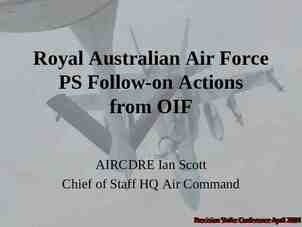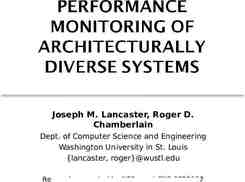Hacking Joshua Lackey, Ph.D.
62 Slides2.15 MB

Hacking Joshua Lackey, Ph.D.

Background Ph.D., Mathematics. University of Oregon. 1995 – 2000 Senior Ethical Hacker. IBM Global Services. 1999 – 2005 Security Software Developer. Microsoft SWI Attack Team. 2005 –

Hacking as a White Hat Introduction Requirements Technical Talk One 50 minute lecture Personal Requirements Not boring

Question Why would anyone spend 1.5k – 2k per day for a penetration test?

Cost/benefit Risk analysis – how? Answer Example – an MSRC bulletin costs between 100k and 200k. – design review, threat model review, history of product/feature, training statistics feed into the risk analysis. – this determines if more work must be performed.

Answer The goal of any penetration test or ethical hack is to determine the truth.

Truth Is what we believe, what we have been told actually true? Is what we designed, what we implemented secure?

Adversarial Situations – “of course we did this securely” Acquisitions Truth – quality analysis – unknown environment Talent – “never even thought of that”

The best plans include security analysis in all phases of development. Truth Design – Penetration testing during design phase provides feedback before implementation. – The worst flaws are design flaws. Implementation – Software developers who understand how to write secure code.

Does it really cost 1.5k – 2k per day per penetration tester? Truth For top-level penetration testers, these are the standard security consultant’s fees. The main reason is that the talent required is not so common.

Examples from work. Problem: Examples I cannot discuss any of my good examples.

Examples from my research. – 802.11 Fragmentation Attack Examples – VW Key Fob – GSM

Examples Most of what I’m going to speak about is works-in-progress. There will be a lot of questions and very few answers.

802.11 Fragmentation Attack (This is finished research.) Serious Design Flaw – trying to gauge how much this cost is difficult. (Especially since most people/companies haven’t addressed this ) Would have been extremely difficult to find in design phase anyway. (Although possible.)

802.11 Fragmentation Attack Best previous attack: Weaknesses in the Key Scheduling Algorithm of RC4. Fluhrer, Mantin, Shamir. Vendors countered by not using weak IVs. Unfortunately, this was not enough. (Although many thought it was.)

802.11 Fragmentation Attack A vulnerability exists in the IEEE 802.11 protocol which allows an attacker the ability to transmit WEP encrypted packets without knowing the encryption key. This vulnerability allows an attacker to decrypt packets as well. This was disclosed to CERT on September 16, 2003.

802.11 Fragmentation Attack RC4 Encryption If we denote by E k(P) the encryption of the plaintext message P by the RC4 encryption method with key k, we have E k(P) X P Where X is the pseudo-random bit-stream generated by the RC4 PRGA with key k . And thus E k(P) P X

802.11 Fragmentation Attack Logical Link Control Packets The most common LLC/SNAP packet seen on an 802.11 network is the Ethernet type LLC with IP. Explicitly, this packet consists of the following eight bytes. P' { 0xaa, 0xaa, 0x03, 0x00, 0x00, 0x00, 0x08, 0x00 }

802.11 Fragmentation Attack Logical Link Control Packets Each encrypted packet on an 802.11 network is encapsulated in a logical-link control packet. That is, each packet P is the concatenation of P', given above, and some P'‘. P P' P''

802.11 Fragmentation Attack Logical Link Control Packets By the above comments on RC4, we can find the first eight bytes of the pseudo-random bit-stream X' generated by the key used to encrypt this packet, X' E k(P') P' Because we know the plain-text P', we can encrypt any arbitrary eight bytes with key k. We have, for any eight byte text Q, E k(Q) X' Q

802.11 Fragmentation Attack 802.11 Fragmentation Section 9.4 of the 1999 IEEE 802.11 protocol specification provides a method to fragment packets when needed. Moreover, each fragment is encrypted individually.

802.11 Fragmentation Attack By transmitting packets in fragments, an attacker can inject arbitrary packets into a WEP encrypted 802.11 wireless network.

802.11 Fragmentation Attack Example Capture a packet, including the 802.11 headers, off a WEP encrypted network. 08 41 02 01 00 04 5a 37 ee 75 00 0e 35 ea 75 17 00 00 24 50 da 11 00 01 55 f9 47 00 db 76 e1 66 14 cf 05 c5 51 06 95 41 70 06 2d 4f 96 0e 0a 01 3c 6f fc bd 38 a2 21 02 33 0c 50 f1 e9 ae a4 8a 5e 16 49 41

802.11 Fragmentation Attack Example If we parse the 802.11 header, we find this packet contains the following. type: data frame, data only to ds: 1, from ds: 1, more frag: retry: 0, pwr mgt: 0, more data: wep: 1, order: 0 dur: 102 a1: 00-04-5A-37-EE-75 a2: 00-0E-35-EA-75-17 a3: 00-00-24-50-DA-11 seq: frag 00, num 0010 data: 55 f9 47 00 db 76 e1 66 70 06 2d 4f 96 0e 0a 01 33 0c 50 f1 e9 ae a4 8a 0, 0, 14 cf 05 c5 51 06 95 41 3c 6f fc bd 38 a2 21 02 5e 16 49 41

802.11 Fragmentation Attack Example The first 10 encrypted data bytes are: db 76 e1 66 14 cf 05 c5 51 06 Assuming that we have a IPv4 packet with a Ethertype LLC/SNAP header, the plain-text data is: aa aa 03 00 00 00 08 00 45 00 Therefore the first ten bytes of the pseudo-random bitstream are derived as follows. db 76 e1 66 14 cf 05 c5 51 06 aa aa 03 00 00 00 08 00 45 00 ------------------------------71 dc e2 66 14 cf 0d c5 14 06

802.11 Fragmentation Attack Example Suppose we wish to transmit an ICMP echo request. 45 00 00 2c 7a 0f 00 00 ff 01 33 b9 01 02 03 04 0a 01 00 02 08 00 6d 81 5d 02 2f 96 69 6e 6a 65 63 74 65 64 20 70 61 63 6b 65 74 00 E.,z.3. .m.]./.inje cted packet.

802.11 Fragmentation Attack Example Break this packet into fragments. fragment 0: data: aa aa 03 00 00 00 crc : f2 bb 67 21 fragment 1: data: 08 00 45 00 00 2c crc : 22 e7 83 c3 fragment 2: data: 25 4c 00 00 ff 01 crc : 8a 4d 83 9f fragment 3: data: 88 7c 0a 01 00 02 crc : a7 d1 72 ff [ ]

802.11 Fragmentation Attack Example For each piece of fragmented data, encrypt with the pseudo-random bit stream and attach an 802.11 header. fragment 0: type: data frame, data only to ds: 1, from ds: 0, more frag: 1, retry: 0, pwr mgt: 0, more data: 0, wep: 1, order: 0 dur: 0 a1: 00-04-5A-37-EE-75 a2: 00-0E-35-EA-75-17 a3: 00-00-24-50-DA-11 seq: frag 00, num 0024 data: 55 f9 47 00 db 76 e1 66 14 cf ff 7e 73 27

802.11 Fragmentation Attack Example Continue. fragment 1: type: data frame, data only to ds: 1, from ds: 0, more frag: 1, retry: 0, pwr mgt: 0, more data: 0, wep: 1, order: 0 dur: 0 a1: 00-04-5A-37-EE-75 a2: 00-0E-35-EA-75-17 a3: 00-00-24-50-DA-11 seq: frag 01, num 0024 data: 55 f9 47 00 79 dc a7 66 14 e3 2f 22 97 c5

802.11 Fragmentation Attack Example Now transmit the fragments. The access point will decrypt each fragment and combine them into a single decrypted packet and forward it to the destination.

802.11 Fragmentation Attack Example I omitted quite a few details, but this is the attack. It has been verified to work against all tested access points. Understandable as all this is specified in the protocol. For an excellent write-up of this attack, see Andrea Bittau’s paper. (Better version that I co-authored is coming soon.) http://www.toorcon.org/2005/slides/abittau/paper.pdf

Now to talk about some research that isn’t finished. Research But first, a small aside.

Once upon a time, radio was for hardware geeks. Software Radio – Expensive equipment. – For digital signals, very expensive equipment. And sometimes not available to the general public. – Of course custom hardware was always an option.

Now we have inexpensive “front end” hardware. Software Radio Uses your computer as the “back end” processor. – Every signal is now only a matter of software. – Free and increasingly full-featured SDR libraries. USRP – The Universal Software Radio Peripheral. http://www.ettus.com

USRP

Two A/D D/A converters – A/D @ 64Msamples/sec – D/A @ 128Msamples/sec USRP Altera FPGA – Field Programmable Gate Array Daughterboard interfaces – For RF integration BasicRX and BasicTX – direct interface to AD/DA TVRX – cable TV tuner interface DBSRX – satellite TV tuner interface

BasicRX @ 64Msamples/sec – Receive frequencies up to 32MHz Daughterboards Broadcast AM Shortwave – Aliased frequencies with decreased signal strength. Not so good for digital. BasicTX @ 128Msamples/sec – Transmit frequencies up to 64MHz

TVRX – cable TV tuner Daughterboards – Receive frequencies from 50MHz to 900MHz Broadcast FM Police (analog and digital) Analog cellular phones (AMPS) Digital mobile phones – DAMPS – GSM – iDEN Etc, etc, etc.

DBSRX – satellite TV tuner Daughterboards – Receive frequencies from 800MHz to 2.5( )GHz GSM CDMA Bluetooth 802.11 Hydrogen (Radio Astronomy) Etc, etc, etc.

Software Radio Wireless Communication Security – Cheap hardware. – Easily available. – Highly flexible. Examining the security of complex wireless protocols is now possible for the independent researcher. We will gradually see more and more of wireless protocol vulnerabilities announced.

Volkswagen Key Fob Examples Every day I unlock my car with a radio. How secure is this? I’m sure if we asked we would be told that, “of course this is secure.” What is the truth? What is the – – Algorithm? Quality of PRNG? (If used.) First step is to gather data.

Volkswagen Key Fob Find key fob transmit frequency Examples FFT signal search Frequency grabber FCC ID Search: https://gullfoss2.fcc.gov/prod/oet/cf/eas/reports/GenericSearch.cfm

FFT Signal Search VW Key Fob

FCC ID Search – Get FCC ID from device. – Grantee code is first three letters. VW Key Fob VW Key Fob: NBG – Frequency is 315MHz. – Modulation type is A1D Amplitude modulation data transmission, double sideband, without using a modulating subcarrier.

Modulation VW Key Fob – FCC gave us modulation. – Can recognize different modulation types from FFT and raw signal. Estimate bandwidth. Filter. Examine closely.

Capture signal (amplitude demod) VW Key Fob

First Signal VW Key Fob

Samples 25000 – 35000 of first signal VW Key Fob

Samples 31000 – 33000 of first signal VW Key Fob

Samples 32110 – 32880 of first signal VW Key Fob

Sampled at 500kHz – Holds low for 250 samples – .5ms – Holds high for 500 samples – 1ms VW Key Fob For initial purposes – Symbol length is .5ms – Low is 0 – High is 1 So the sample we were looking at was 011

Demod VW Key Fob – transmit Frequency – signal bandwidth – guess at symbol modulation Now just write some software!

Examined 100 examples. No repeats although there are definite patterns. VW Key Fob Next steps Probably easiest thing to do would be to examine the demoded data for statistical patterns. (Diehard) See Bindview paper on strange attractors in TCP sequence numbers. http://www.bindview.com/Services/Razor/Papers/2001/tcpseq.cfm

GSM Documentation is very good and design flaws can be identified there. What about implementation flaws? Next What encryption does my phone use? – A5/1 and A5/2 hacked. – Actually, how do I know I’m using any encryption at all? How about random numbers? How about man-in-the-middle attacks? – Requires transmit and so probably illegal to test.

Find transmit frequency. FFT Signal Search GSM – just knowing the bandwidth is actually good enough – FCC Search for towers in your area – Documentation http://www.3gpp.org/specs/numbering.htm

Turns out I have two strong signals reachable from my computer room. GSM One at 1.9474GHz and the other at 1.9468GHz.

GSM Tower at 1.9474GHz with 1MHz DBS filter. GSM

Modulation type is GMSK (or 8PSK) GSM

Capture signal (Samples 2M – 3M @4Msps.) GSM

Samples 2M – 2.001M GSM

Now, write some software! BCCH (SCCH) GSM – – – – – FIRE parity convolutional encoder / Viterbi decoder block interleaving map on burst content parsing Next channel

Penetration testing can be useful – cost/benefit. Costs for mistakes can be very high. Conclusion Software radio is cool. More info? Ideas? Send me email: [email protected]






